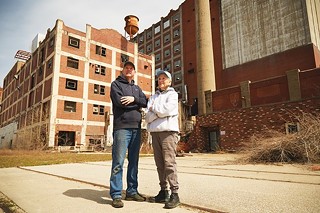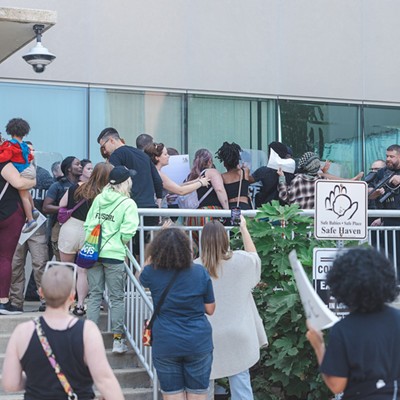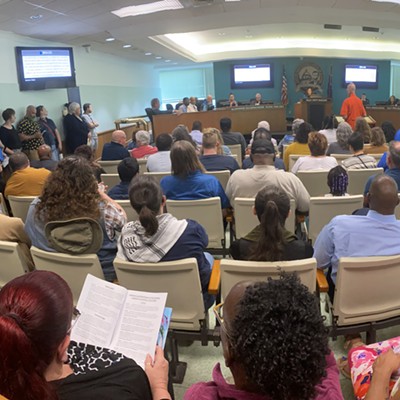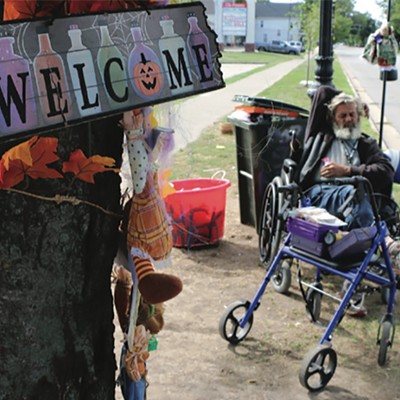By this time next year, most of the buildings – other than the "head house" and the 160 long-empty grain silos – will be demolished at the site of the former Pillsbury Mills plant on Springfield's north end.
That's what $1.5 million in spending set in motion by ordinances passed Feb. 20 by the City Council will accomplish, according to the president of Moving Pillsbury Forward.
"It's very important for the project," Chris Richmond told Illinois Times a few hours before the council passed the ordinances to spend the money from federal and local sources.
The votes mean $6 million has been raised to offset the estimated total $10 million to $12 million it will take to demolish buildings and remove hazardous materials in the buildings and soil at 1525 Phillips Ave.
The votes also mark a second infusion of cash from Springfield city government in a community effort to repurpose a site that had been a major industrial hub in Springfield since 1929 but later became an eyesore.
A dog spotted roaming the vacant site and later found dead from ingesting rat poison in October 2019 symbolized the "sense of hopelessness" infusing the site and spilling over into the adjacent working-class neighborhood, Richmond said.
That incident helped spur volunteer efforts that coalesced in Moving Springfield Forward. The nonprofit later bought the site for $1 and spearheaded efforts to clear it for future light or medium industrial use.
The efforts could culminate in two years and eventually lead to employment and other economic benefits for the neighborhood and Springfield as a whole, Richmond said. About 12,000 people live within a one-mile radius of the site, he said.
Pillsbury Co., which was acquired in 2001 by Minneapolis-based General Mills, built the grain processing plant and opened for business in 1929. The site once was a major nationwide supplier of Pillsbury flour, cake mixes and brownie mixes, employing up to 1,500 people or more in the 1950s.
The 160 100-feet-tall bins on either side of the 20-story head house held as many as 3 million bushels of wheat brought to the site by trucks and rail cars.
Pillsbury sold the site to Cargill in 1991, and Cargill ran the plant as a grain storage facility for about 10 years. The facility then sat vacant until 2008, when it was sold to the first of a series of owners that removed scrap metal.
Initial work to conduct environmental studies, fund consulting work and pay for some cleanup at the site has been funded in part by the Springfield-Sangamon Growth Alliance, which contributed $260,000 to the effort. The money from the alliance included $100,000 appropriated by the City Council.
In addition, the Community Foundation for the Land of Lincoln has chipped in almost $40,000 and committed to another $40,000.
Cleanup efforts so far have resulted in the removal of three structures and removal of 500 tons of garbage and debris, largely with volunteer help, Richmond said.
The City Council on Feb. 20 decided to contribute $500,000 to the project from funds the city received from the American Rescue Plan Act. Also appropriated were up to $500,000 in property taxes from the Madison Park Place Tax Increment Financing District and $250,000 apiece from the city's corporate fund and federal community development block grant funding.
That money is expected to begin flowing later this year, beginning in the summer, Richmond said. The money will be added to federal funds expected to arrive this year after Congress, with help from U.S. Sen. Dick Durbin, D-Springfield, approved $2 million for the project in 2023.
Also working their way to the project are an $800,000 cleanup grant from the U.S. Environmental Protection Agency that was announced in 2023, and $1.3 million in grants, also announced last year, from the Illinois Department of Commerce and Economic Opportunity.
Included in the amount Richmond counts in the $6 million raised for the project is $500,000 from city government over the next two to three years that city officials have committed to spend. That spending would require future votes of the City Council.
Moving Pillsbury Forward has applied for another $1 million in federal funds with the help of U.S. Rep. Nikki Budzinski, D-Springfield. The group also has applied for another $2.6 million from the U.S. EPA.
Those federal funds should cover the demolition and removal of the head house and the grain silos, which contain lead paint and asbestos and require special care to avoid contamination, Richmond said.
He noted that the head house, standing 225 feet tall, is the third-highest structure in Sangamon County, behind the Capitol, which is the tallest, and the Wyndham Springfield City Centre hotel.
Moving Pillsbury Forward hopes to sell the site to a future developer or developers, and the groups probably will need to work together to fund a few million dollars to remove contaminated soil from the site, Richmond said. The site is just west of a rail yard.
Organizers of Moving Pillsbury Forward are "feeling pretty good" about the project's momentum, Richmond said.
Richmond, 55, is a retired Springfield firefighter and former city fire marshal whose father worked at Pillsbury for 21 years.
The nonprofit has welcomed more than 3,000 people who have toured the site over the past 12 months, he said.
The progress thus far "really speaks well to our community," he said. "Hopelessness is not an option in our community."
Dean Olsen is a senior staff writer at Illinois Times. He can be reached at 217-679-7810, [email protected] or twitter.com/DeanOlsenIT.





















